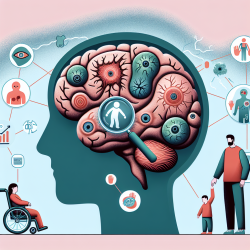Introduction
The recent study titled "Phenotypic expansion of the BPTF-related neurodevelopmental disorder with dysmorphic facies and distal limb anomalies" provides crucial insights into the complexities of neurodevelopmental disorders linked to the BPTF gene. This research expands our understanding of the phenotypic spectrum associated with these disorders, offering new avenues for practitioners to explore in their therapeutic approaches.
Key Findings
The study identifies 25 new individuals with distinct BPTF variants, broadening the clinical features associated with BPTF-related disorders. In addition to previously known symptoms such as developmental delay, intellectual disability, and dysmorphic features, new findings include:
- Mild brain abnormalities
- Seizures
- Scoliosis
- Ophthalmologic complications
These findings underscore the multifaceted complications arising from BPTF haploinsufficiency, emphasizing the need for comprehensive assessment and intervention strategies.
Implications for Practitioners
For practitioners, these findings highlight the importance of a holistic approach in diagnosing and managing BPTF-related neurodevelopmental disorders. Here are some practical steps to enhance therapeutic outcomes:
- Multidisciplinary Collaboration: Engage with geneticists, neurologists, and other specialists to ensure a comprehensive understanding of the patient's condition.
- Customized Therapy Plans: Tailor therapy sessions to address the specific needs identified in each patient, considering both physical and cognitive challenges.
- Continuous Education: Stay informed about the latest research and advancements in genetic disorders to refine therapeutic techniques.
- Family Involvement: Work closely with families to educate them about the disorder and involve them in the therapeutic process.
Encouraging Further Research
The study opens up numerous possibilities for further research. Practitioners are encouraged to contribute to this growing body of knowledge by:
- Documenting unique cases and sharing findings with the broader scientific community.
- Exploring the genetic underpinnings of other neurodevelopmental disorders to identify potential overlaps and distinctions.
- Participating in clinical trials and collaborative research initiatives.
Conclusion
The expansion of the phenotypic spectrum of BPTF-related disorders calls for a proactive and informed approach in therapy and research. By integrating these insights into practice, practitioners can significantly enhance the quality of care provided to individuals affected by these complex disorders.
To read the original research paper, please follow this link: Phenotypic expansion of the BPTF-related neurodevelopmental disorder with dysmorphic facies and distal limb anomalies.










